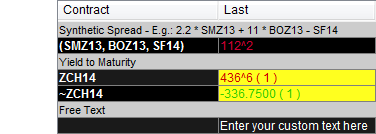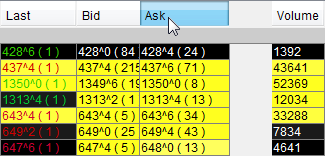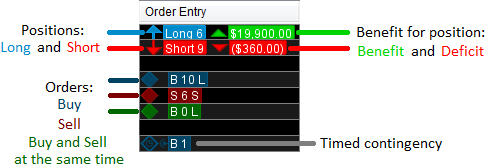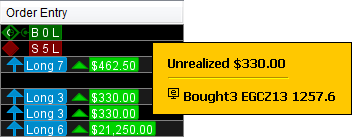 Quotes Monitor
Quotes Monitor
|
|
 Quotes Monitor
Quotes Monitor
The Quotes Monitor module allows one to follow real-time quotes for a customizable set of instruments. Depending on the software configuration, access to several frames of this type may be available.
|
Basically, each Quotes Monitor consists of one or more tables (if more are present, use the tabs at the bottom to switch between tables). In the example above, there are many tabs and the last three are: one for Agriculturals, one for miscellaneous quotes and one that the user labeled as "Most used". When your Quotes Monitor tabs exceed the width of your screen, you can navigate between them by using the controls on the panel marked in the image on the right. You can change the order of the tabs in a table by drag-and-drop. To invert the tabs, for example the Metals tab with Treasuries (take a look at the image on the right), left click on one of the tabs and while holding the mouse key down, drag it to its new position. In order to hide these tabs, you can use the Toggle |

|

|
Each row will either:
|

|
|
For example, click on an empty Contract cell to start typing in a contract, such as ZC, select the desired trading month, then hit Enter to submit. |

|
|
You can also type (in a Contract cell) title: any_text you want to use for a title row and hit Enter. Please take a look at the screenshot on the right. To learn more about using the Contract cell, click here. |

|
|
User-typed expressions - that can be displayed in a Quotes Monitor frame - include: Synthetic Spreads Enumerations of contracts, such as (SM, BO, S), for which, by default, the following formula is applied: 2.2*SM + 11*BO – S (as far as pricing goes). An order placed on such an expression will use 11, 9, -10 as coefficients. Yield to Maturity This calculates the interest rate for the future contracts by a default formula. Just type the contract's name with the ~ sign in front. E.g.: ~ZCH14. Free Text Used for comments/notes; just type whatever text you want in any empty cell (except a Contract one). |

|
|
Formulas and Functions You can create various formulas in any cell (except the Contract column), as long as that row is not already occupied by a contract. All formulas must start with the = symbol. You can specify contracts to be used in these functions and formulas by typing the full contract, such as ESH14 or type the symbol followed by * to represent the entire calendar strip for that contract, such as ES*. You can extract the information provided by a certain column of the contract by typing @ followed by the symbol of the column. E.g.: =ESH14@VOL. Here is the list of available columns and their symbols:
You can use any arithmetic formula (+, -, *, /) and well as the INT and SUM functions. The INT function can be used to display the integer value of a certain column or formula. In order to use this function, type INT and put the value you want to convert to integer in brackets. The SUM function is similar to the one in Excel. Type SUM and then put the elements you want to sum up in brackets. For example, the following formulas return the same result: =SUM(ESZ13@VOL, ESH14@VOL) or =ESZ13@VOL+ESH14@VOL. Both of the following two formulas sum the volumes for the entire calendar strip: =SUM(ES*@VOL) or =SUM@VOL(ES*). |

|
|
Pack Strategy Support It is possible to calculate a synthetic pack price and compare it to the exchange-traded instrument. For example, the symbol for a 3-month Class III Milk Pack for January 2014 is DCF14:3M[FS]. The formula to compute this synthetically based on the bid/ask of the Jan, Feb and Mar '14 futures contracts would be: DCF14@NC /3 + DCG14@NC /3 + DCH8@NC /3. Note that the @NC qualifier is utilized because this pack is quoted by the exchange as the average of the net change from the previous trading session. The @NC qulaifier substitutes the net change for the last, bid or ask price in the calculation. This allows the user to directly compare the last, bid and offer of the exchange-traded instrument against the aggregate last/bid/ask of the individual legs. If the bid/ask is better for the outright futures contracts, the user can attempt to leg into the pack using the Spread Legger functionality. If the user prefers to look at the pack quotes as the average of the prices, rather than the average of the net change, he can use the ~ as follows: DCF14~3M. This will show the 3-month pack for Class III Milk according to the average price of the three months. However, when the user goes to place an order, the price is automatically converted to the equivalent average net change so that it is accepted and properly priced by the exchange. |

|
|
In order to facilitate access / allow quick combinations of the above expressions, Quotes Monitor offers the following shortcuts: |
|
You can change the order of the rows in a table by drag-and-drop. To invert the rows, for example the 6EZ14 with CH14 (take a look at the image on the right), left click on one of the rows and while holding the mouse key down, drag it towards to it's new position. In order to disable this functionality go to the Advanced tab of the Quotes Monitor Properties dialog and check the Disable rows drag and drop option from the Other section. Please note that this will work only if your interaction with Quotes Monitor takes place while in One-click-trading Mode. The way a user interacts with the rows is defined by a setting; one may be either in Selection Mode or in One-click-trading Mode. The first allows one select cells for dynamic export, while the latter allows quick order placement. These are described below, where relevant. |

|

|
Columns divide each row into cells that classify the information. In order to read more about the available columns, please click here. |

|
|
You can change the order of columns in a table by drag-and-drop. To invert the Bid and Ask columns, for example, left click on the Ask header and while holding the mouse key down, drag it towards the Bid's location. |

|

|
An order can be placed from the Quotes Monitor frame by left- or right-clicking one of the Last / Bid / Ask columns (tip: use these columns to place orders from within any frame that shows them). Make sure that in Quotes Monitor you interact with the frame while in the One-click-trading Mode. (For a general (but in-depth) Order Entry introductory material, please take a look at the Order Entry section of this Help. You can change your Order Entry settings from the Order Entry Properties dialog. Click here to learn more about these.) Back to Quotes Monitor, you can always check the Order Entry cells within this frame for details regarding your orders and positions. If this column is not displayed, please add it by going to the Columns tab of the Quotes Monitor Properties dialog. Use the same cells to place contingent orders. Learn more more about Contingencies here. |

|
|
While hovering the mouse over the Order Entry cell in the Quotes Monitor, the tooltip (if active) will display real-time account updates. In order to enable this tooltip, please go to the Advanced tab from the Quotes Monitor Properties dialog. (Although the "mechanics" of placing orders on synthetic (mathematical) spreads are the same, we suggest the reader to familiarize with the Spread Legger functionality to learn about behavior details.) |

|

Depending on the location in the frame one right-clicks on, different pop-up menus will be displayed. These can be used to accelerate certain actions in the frame.
More information about the Pop-up Menu in Quotes Monitor can be found here.

Buttons on the Quotes Monitor Toolbar are described in a separate Help file, located here.
Information about the toolbar's location in the Application Layout is available here.

The Quotes Monitor Properties dialog provides access to change any Quotes Monitor setting.
Help for use of this dialog and its tabs is located here.
